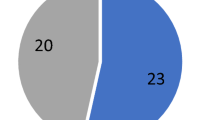Abstract
To estimate the prevalence of Sensorineural hearing loss and evaluate the severity of hearing impairment in patients undergoing second line injectable antitubercular treatment. To study the effects of duration of treatment, dose schedule and demographic factors which aggravates anti TB drug induced ototoxicity. Design–prospective and retrospective study Setting-ENT & TB clinic at our hospital and TB Hospital of Subject-18–50 year age , diagnosed MDR or XDR TB Method–baseline puretone audiometry was done of all patients. all patients divided in 3 group depending on aminoacid (amikacin , kanamycin, capreomycin). Follow up PTA was done at 3rd month, 6th month and 6 month after stopping treatment 35.48% of Group 1 (kanamycin) patients show High frequency hearing loss and 16% of patient have both high and low frequency hearing loss High frequency hearing loss 21% of Group 2 (amikacin) patients show High frequency hearing loss and 5% of patient have both high and low frequency hearing loss 20% of Group 3 (capreomycin) patients show High frequency hearing loss with no patient resulted low frequency loss Patients treated FOR MDR-TB develop significant adverse effects. Clinicians must consider risk benefit analysis during treatment as ototoxicity of injectable aminoglycoside ATT is permanent. Early detection of hearing loss through pure tone audiometry helps preventing and progression of hearing loss without compromising the treatment.





Similar content being viewed by others
References
World health organisation, Geneva, Switzerland. Global tuberculosis control. WHO/HTM/TB/2011162011
Seimoglu E (2007) Aminoglycoside-induced ototoxicity. Curr Pharm Des 13:119–126
Guthrie OW (2008) Aminoglycoside induced ototoxicity. Toxicology 249:91–96
Americal speech-language-hearing association audiologic screening (technical report)
American speech-langug- hearing association audiologic management of individuals receving cochiotoxic drug therapy (guidline) 1994
Sharma V, Bhagat S, Verma B, Singh R, Singh SP (2016) Audilogical Evaluation of patients taking Kanamycin for multidrug resistant tuberculosis. Iranian J Otorhinolaryngol 28(3):86
Ashish Kumar C, Zala Nitesh Gamit, Manwar Ruchita M, Kanthariya ND (2015) Assessment of prevalence of kanamycin induced ototoxicity in MDRTB patient in tertiary care hospital. Ejpmr 2(4):1221–1225
Peloquin CA, Berning SE, Nitta AT, Simone PM, Globe M, Huitt GA, Iseman MD, Cook JL, Curran-Everett D (2004) Aminoglycoside toxicity; daily versus trice-weekly dosing for treatment of mycobacterial disease. Clin Infect Dis 38:1538–1544
Modongo C, Sobota RS, Kesengile B, Ncube R, Si Rugo G, William SM, Zetola NM (2014) Successful MDR-TB treatment regimens include Amikacin are associated with high rates of hearingloss. BMC Infect Dis 14:542
Nizamuddin S, Khan FA, Khan AR, Kamaal CM (2015) Assessment of hearing loss in multi-drug resistant tuberculosis (MDR-TB) patients undergoing aminoglycoside treatment. Injt J Res Med Sci 3(7):1734–1740
Joseph P, Desai VBR, Mohan NS, Fedrick JS, Raman B, Wares F, Ramachandran R, Thomas A (2011) Outcome of standardized treatment for patient with MDR-TB from Tamilnadu India. Indian J Med Res Suppl 133:529–534
Duggal P, Sarkar M (2007) Audiologic monitoring of multi-drug resistant tuberculosis patients on aminoglycosisde treatment with long term follow up. BMC Ear Nose Throat Disord 7:5
Author information
Authors and Affiliations
Corresponding author
Rights and permissions
About this article
Cite this article
Verma, J., Syed Mohammed, T. Evaluating Hearing Loss in Patients Undergoing Second Line Anti Tubercular Treatment. Indian J Otolaryngol Head Neck Surg 71 (Suppl 2), 1202–1206 (2019). https://doi.org/10.1007/s12070-018-1266-y
Received:
Accepted:
Published:
Issue Date:
DOI: https://doi.org/10.1007/s12070-018-1266-y




